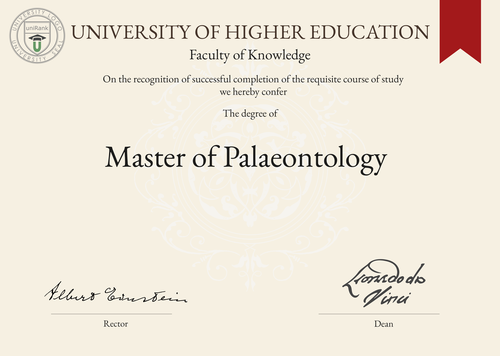
Master of Palaeontology (M.Palaeo.)
Guide to Master of Palaeontology Program/Course/Degree
Master of Palaeontology (M.Palaeo.)

Program Name
Master of PalaeontologyProgram or Degree abbreviation
M.Palaeo.Duration range
The duration of the Master of Palaeontology program typically ranges from 1 to 2 years.Tuition range
The tuition fees for the Master of Palaeontology program can vary depending on the chosen country or university. It is recommended to check with specific institutions for accurate information.Overview
The Master of Palaeontology program is designed to provide students with a comprehensive understanding of the field of palaeontology, focusing on the study of ancient life forms and their environments. Students will gain knowledge and skills in fossil identification, excavation techniques, geological analysis and evolutionary biology.Curriculum Overview by year
Year 1: - Introduction to Palaeontology - Fossil Identification and Classification - Sedimentology and Stratigraphy - Paleobiology - Fieldwork and Excavation Techniques Year 2: - Advanced Palaeontological Techniques - Paleoenvironmental Reconstruction - Evolutionary Patterns and Processes - Research Methods in Palaeontology - Master's ThesisKey Components
The key components of the Master of Palaeontology program include: - In-depth study of fossil identification and classification - Hands-on experience in fieldwork and excavation techniques - Understanding of sedimentology, stratigraphy and paleobiology - Advanced techniques for palaeontological research - Development of critical thinking and analytical skills in the field of palaeontologyCareer Prospects
Graduates of the Master of Palaeontology program can pursue various career paths, including: - Palaeontologist - Museum Curator - Research Scientist - Environmental Consultant - Academic ProfessorSalary Expectations
The salary expectations for individuals with a Master of Palaeontology degree can vary depending on factors such as experience, location and job position. On average, palaeontologists can earn a salary ranging from $50,000 to $100,000 per year. For a more accurate understanding of salary expectations, you can utilize the Job Sites Search Engine, from our sister site jobRank, which searches over 4,600 job sites worldwide. Make sure to specify not only the job title but also the country you are interested in.Conclusions:
It is important to note that the duration, tuition fees, curriculum, key components, career prospects and salary expectations of the Master of Palaeontology program can vary depending on the chosen country or location of study, as well as the specific university offering the program. Prospective students are advised to research and compare different institutions to find the best fit for their academic and career goals. Visitors can search for where the Master of Palaeontology degree is offered anywhere in the world through the uniRank World Universities Search Engine, which provides comprehensive information on universities and their programs worldwide.World Universities Search Engine
search for Master of Palaeontology (M.Palaeo.) and add the Location (country, state etc.) or specific University you are interested in studying at.
Query examples:
- Master of Palaeontology (M.Palaeo.) United States
- Master of Palaeontology (M.Palaeo.) United Kingdom online
- Master of Palaeontology (M.Palaeo.) Australia international students
- Master of Palaeontology (M.Palaeo.) University of California
- Master of Palaeontology (M.Palaeo.) University of London tuition fees
- Master of Palaeontology (M.Palaeo.) University of Sydney scholarships
Share Program/Course
Interesting? Share this program/course/degree info with your friends now.